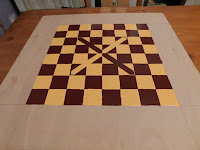As a basis for the board, I got myself a rubberwood cutting board. I felt the colour would fit nicely with the pieces, and also liked the 'feel' of the wood.
I wanted a simple board, and uhm-ed and ah-ed quite a bit as to how to create the squares. Got ideas and then rejected them again later when I came to the realisation it just didn't quite work. To make a long story short, I finally decided on simple pyrography: burn the lines into the board, using a soldering iron.


Must admit I was pretty pleased with how it turned out! Plus it gave me an unexpected bonus: burning the lines into the wood smells quite nice.
Traditional Japanese shogi boards sometimes have short 'feet' of some sort, turning the board into a very low table. I wanted to do something along those lines, and got myself four wooden half-spheres, to serve as 'table legs'.

Final flourish was to burn the Japanese characters for 'shogi' into the board. That area of the board is where the captured pieces are to be kept, in preparation for a 'drop', and in clear view of the opponent.
Which means the board is ready for the pieces.


I'm much happier with this simple shogi board; leaves the old one far behind!



































